Player Down!
Simulation fine-tunes USF athletic training students’ response to on-field emergencies

With the increased national focus on concussion and spinal injuries in football, USF has stepped up proactive measures to insure that those who take care of the athletes practice responding to these on-field emergencies. Emergency care has always been included as part of the athletic training curriculum at USF, but the ability to practice in “game-like” situations has been limited.
Recently, USF athletic training students who will graduate in May and begin work as athletic trainers at high schools, colleges and universities, and other sports venues, completed a lifelike simulation. They used i-Stan, a high-fidelity simulator, to re-enact a potential catastrophic injury on the football field. Previously, students (and professionals) practiced using a standardized patient – a person trained to portray symptoms of a traumatic injury — but life-threatening situations were not sufficiently realistic. That all changed this fall when the simulation, described below, was created and performed for the first time by the students.
* * *
Six athletic training students rush into the room to see the USF Bulls football player, unconscious, face down on the artificial turf.
Minutes before the group had watched video of an actual game where an opposing player slammed into the midsection of a Bulls lineman, leaving the injured player motionless on the field.
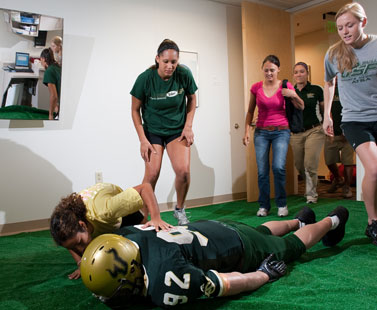
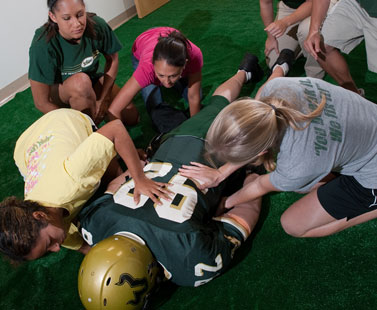
Now, the students quickly assume their positions on either side of iStan, decked out in full football gear for this emergency spine injury scenario in the Center for Advanced Clinical Learning. The computerized mannequin’s face is covered with beads of sweat – courtesy of a few spritzes with a water bottle before the students arrived.
“Are you OK? Are you OK?… Call 911!” one shouts, checking for breathing and a pulse and detecting neither. The team springs into action, rolling the unconscious “athlete” over onto his back on the count of 3, while leader Christine Ortega steadies his head and neck. One student starts to remove the face mask from the helmet, while another cuts open the jersey and begins CPR. Still a third student applies electrode pads from an automated external defibrillator (AED) to the mannequin’s bare chest. Still no pulse detected.
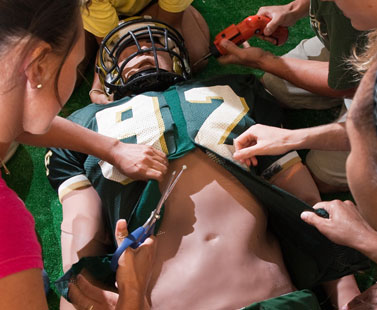
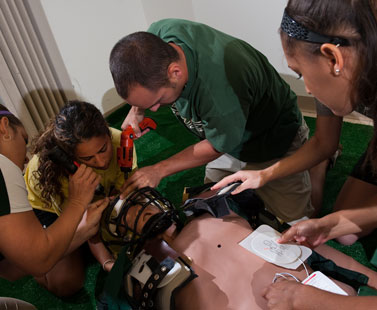
On the other side of the room Fred Slone, MD, the simulation center’s medical director, keeps a watchful eye on the students’ responses and adjusts the mannequin’s computer scenario accordingly. The students move clear of iStan and deliver a shock to the heart with a push of the AED button. After the shock is delivered, they continue CPR, one bagging and another focusing on chest compressions. The AED indicates that another shock is advised. This time the shock defibrillates the heart. “He’s breathing – I got a pulse… still not conscious!” one student shouts.
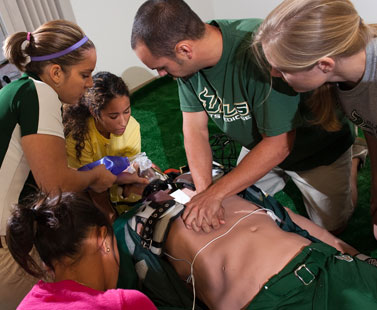
In unison, three students roll the player at a 45-degree angle onto his right side and then gently lower him onto a spine stabilization board. Two students strategically adjust mobilization devices to keep the head and neck from moving – vital for preventing further damage from any dislocation or fracture. Exercise accomplished, this “injured athlete” is ready for transport to the emergency room.
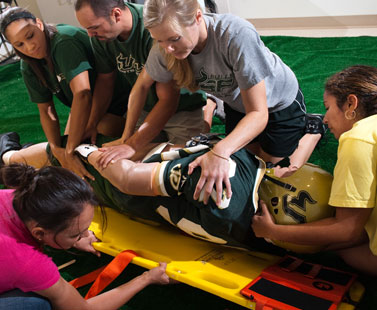
Back in the classroom, the students intently watch a replay of the recorded scenario and critique their performance. Micki Cuppett, EdD, ATC, director for the Athletic Training Education Program, leads the debriefing session, assisted by faculty members Barbara Morris, MS, ATC, and Gianluca DelRossi, PhD, ATC.
Overall the students worked well communicating and had all the equipment they needed at their sides, the instructors noted, but there were some missteps. The faculty members matter-of-factly, and nonjudgmentally, point them out.
“When you went to the AED, the patient still had a pulse,” Cuppett said. “Whoever was checking the pulse wasn’t checking at the right spot.”
The tape is stopped at place where the students are struggling to remove the face mask from the helmet in order to start CPR. “It’s three minutes and 12 seconds into this and you still don’t have his face mask off. It should be off in 2 minutes or less,” Cuppett said. “What happened?.. You need to get that face mask off and get him some oxygen. If you could have done those things quicker, you might have prevented him from going into defibrillation.”
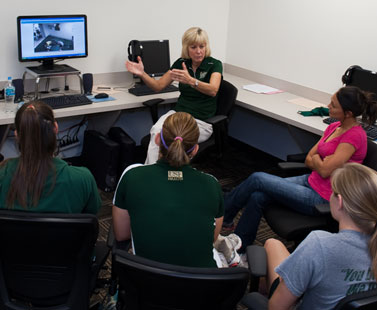
Above: Micki Cuppett, EdD, ATC, director for the Athletic Training Education Program, replays the simulation exercise so faculty and students can critique the students’ performance. Below: USF athletic training students Rachel Dorling, left, and Jennifer Mamazza listen during the post-simulation debriefing.
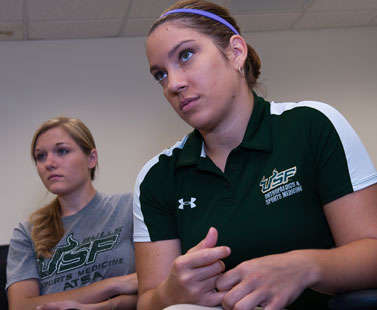
A student explains that removal of the face-mask screws was delayed because the wrong side of the screwdriver bit had been inadvertently inserted into the drill.
“So what’s the take home message here?” Morris asks, and then answers, “Know your equipment.”
Cuppett points out that, with upper spine injuries, a player’s breathing can shut down but a pulse can remain for a short while until it runs out of oxygen. “It’s important that you reassess frequently,” she said. Starting chest compressions quickly is critical as well, she adds. “You’ve got to get the blood circulating.”
The faculty members remind their students that simulation is an opportunity to learn from mistakes in a risk-free setting, so they’ll be better prepared for real-life athlete injuries on the field. “Take this as a learning experience, and know you’ll do better next time,” Morris said.
The students leave encouraged that they’ll have a chance to practice the same scenario again before the year ends.
* * *
In January and early February, Cuppett presented this iStan simulation at the International Meeting for Simulation in Health Care, the Human Patient Simulation Network Conference, and the Southeast Athletic Trainers Association Educators Conference. Future plans include collaborating with other athletic trainers and healthcare providers in the community to allow teams to practice the life-threatening situation in a controlled environment.
– Story by Anne DeLotto Baier, USF Health Communications
– Photos by Candace Mundy, Focus From The Heart, LLC, www.focusfromtheheart.com

